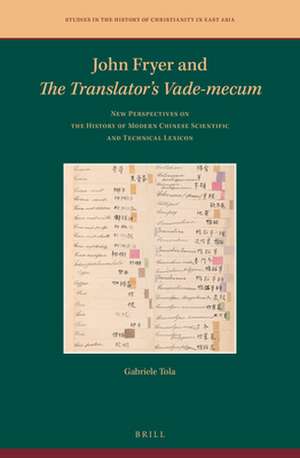John Fryer and <i>The Translator’s Vade-mecum</i>: New Perspectives on the History of Modern Chinese Scientific and Technical Lexicon: Studies in the History of Christianity in East Asia, cartea 4
Autor Gabriele Tolaen Limba Engleză Hardback – 18 noi 2020
In John Fryer and The Translator’s Vade-mecum, Tola offers for the first time a comprehensive study of the collection of scientific and technical glossaries, with English-Chinese parallel translation, compiled by the English scholar John Fryer (1839–1928). Other than contributing to the history of modern Chinese lexicon and translation in late Qing China, Tola analyses the role of The Translator’s Vade-mecum in the diffusion of ideas and terms between China and the West, at the same time providing new insights on the connection between religious efforts by missionaries in late Qing China and their secular attitude towards translation. The great number of resources presented also show a new perspective on the transcultural flows of knowledge, China’s modernisation process in the nineteenth and twentieth centuries and the history of nineteenth-century Protestant missions in China.
Preț: 768.61 lei
Preț vechi: 937.34 lei
-18% Nou
Puncte Express: 1153
Preț estimativ în valută:
147.08€ • 154.26$ • 122.44£
147.08€ • 154.26$ • 122.44£
Carte indisponibilă temporar
Doresc să fiu notificat când acest titlu va fi disponibil:
Se trimite...
Preluare comenzi: 021 569.72.76
Specificații
ISBN-13: 9789004442207
ISBN-10: 9004442200
Dimensiuni: 155 x 235 mm
Greutate: 0 kg
Editura: Brill
Colecția Brill
Seria Studies in the History of Christianity in East Asia
ISBN-10: 9004442200
Dimensiuni: 155 x 235 mm
Greutate: 0 kg
Editura: Brill
Colecția Brill
Seria Studies in the History of Christianity in East Asia
Cuprins
Acknowledgements
List of Figures and Tables
Abbreviations
Introduction
1 John Fryer and The Translator’s Vade-mecum
1 Introduction
2 John Fryer: Between Translation and Scientific Divulgation
3 The Translator’s Vade-mecum: An Authoritative Work
4 Conclusion
2 Planning, Publication, and Setbacks: The Translator’s Vade-mecum
1 Introduction
2 Various Dating Problems
3 Translator’s Vade-mecum and Chinese and English Technical Vocabularies
4 Planning and Birth of The Translator’s Vade-mecum
5 Conclusion
3 Fryer’s Theories on Translation into Chinese
1 Introduction
2 Religious Views and Technical Nomenclature: Discrepancies and Responsibilities
3 Between “The Descriptive” and “The Phonetic” Methods
4 Advice of the Translator: Fryer’s Suggestions
5 Conclusion
4 Published Glossaries
1 Introduction
2 Vocabulary of Mineralogical Terms
3 Vocabulary of Names of Chemical Substances
4 Vocabulary of Names of Materia Medica
5 Vocabulary of Terms Relating to the Steam Engine
6 Vocabulary of Proper Names
7 Conclusion
5 Unpublished Glossaries
1 Introduction
2 “Vocabulary of Terms in Naval Architecture”
3 “List of Botanical Terms”
4 Case Study—Sources of the “List of Botanical Terms”: An Analysis
5 “Vocabulary of Geological Terms”
6 “Botanical Terms from William’s Syllabic Dictionary of the Chinese Language”
7 “List of Geographical Names”
8 “Syllabary for the Transfer of Foreign Names into Chinese”
9 “Vocabulary of Proper Names”
10 Conclusion
6 Lexicological Features and Translation Choices: Conveying New Concepts with Old Terms and Lexical Innovations
1 Introduction
2 Phonemic Loans
3 Hybrids
4 Calques
5 Descriptive Labelling
6 Multiple Translations
7 Using Existing Nomenclature
8 Neologisms: Dating Back through Etymological Dictionaries
9 Neologisms: Dating Back through Databases
10 Beyond Lexical Innovations
11 Conclusion
7 The Translator’s Vade-mecum: Role, Diffusion, and Influence on Later Texts
1 Introduction
2 Encyclopaedias, Collectanea, and Periodicals
3 Dictionaries, Vocabularies, and Glossaries
4 Yan Huiqing’s Ying-Hua da cidian
5 Other Works
6 Conclusion
8 The Translator’s Vade-mecum: Later Aftermath
1 Introduction
2 Chemistry: Texts by the Guoli Bianyiguan and Other Committees
3 Beyond Chemistry: Other Branches of Science
4 Lexicological Legacy: Acknowledgement and Appraisal
Conclusions
Appendix: Synoptic Tables and Reproductions—Contents of the TVM
Bibliography
Index
List of Figures and Tables
Abbreviations
Introduction
1 John Fryer and The Translator’s Vade-mecum
1 Introduction
2 John Fryer: Between Translation and Scientific Divulgation
3 The Translator’s Vade-mecum: An Authoritative Work
4 Conclusion
2 Planning, Publication, and Setbacks: The Translator’s Vade-mecum
1 Introduction
2 Various Dating Problems
3 Translator’s Vade-mecum and Chinese and English Technical Vocabularies
4 Planning and Birth of The Translator’s Vade-mecum
5 Conclusion
3 Fryer’s Theories on Translation into Chinese
1 Introduction
2 Religious Views and Technical Nomenclature: Discrepancies and Responsibilities
3 Between “The Descriptive” and “The Phonetic” Methods
4 Advice of the Translator: Fryer’s Suggestions
5 Conclusion
4 Published Glossaries
1 Introduction
2 Vocabulary of Mineralogical Terms
3 Vocabulary of Names of Chemical Substances
4 Vocabulary of Names of Materia Medica
5 Vocabulary of Terms Relating to the Steam Engine
6 Vocabulary of Proper Names
7 Conclusion
5 Unpublished Glossaries
1 Introduction
2 “Vocabulary of Terms in Naval Architecture”
3 “List of Botanical Terms”
4 Case Study—Sources of the “List of Botanical Terms”: An Analysis
5 “Vocabulary of Geological Terms”
6 “Botanical Terms from William’s Syllabic Dictionary of the Chinese Language”
7 “List of Geographical Names”
8 “Syllabary for the Transfer of Foreign Names into Chinese”
9 “Vocabulary of Proper Names”
10 Conclusion
6 Lexicological Features and Translation Choices: Conveying New Concepts with Old Terms and Lexical Innovations
1 Introduction
2 Phonemic Loans
3 Hybrids
4 Calques
5 Descriptive Labelling
6 Multiple Translations
7 Using Existing Nomenclature
8 Neologisms: Dating Back through Etymological Dictionaries
9 Neologisms: Dating Back through Databases
10 Beyond Lexical Innovations
11 Conclusion
7 The Translator’s Vade-mecum: Role, Diffusion, and Influence on Later Texts
1 Introduction
2 Encyclopaedias, Collectanea, and Periodicals
3 Dictionaries, Vocabularies, and Glossaries
4 Yan Huiqing’s Ying-Hua da cidian
5 Other Works
6 Conclusion
8 The Translator’s Vade-mecum: Later Aftermath
1 Introduction
2 Chemistry: Texts by the Guoli Bianyiguan and Other Committees
3 Beyond Chemistry: Other Branches of Science
4 Lexicological Legacy: Acknowledgement and Appraisal
Conclusions
Appendix: Synoptic Tables and Reproductions—Contents of the TVM
Bibliography
Index
Notă biografică
Gabriele Tola, Ph.D. (2016), formerly JSPS postdoctoral fellow at Kansai University, is a research associate at Sapienza University of Rome. He has published articles on Chinese lexicography and missionary linguistics in international journals, such as Monumenta Serica.








